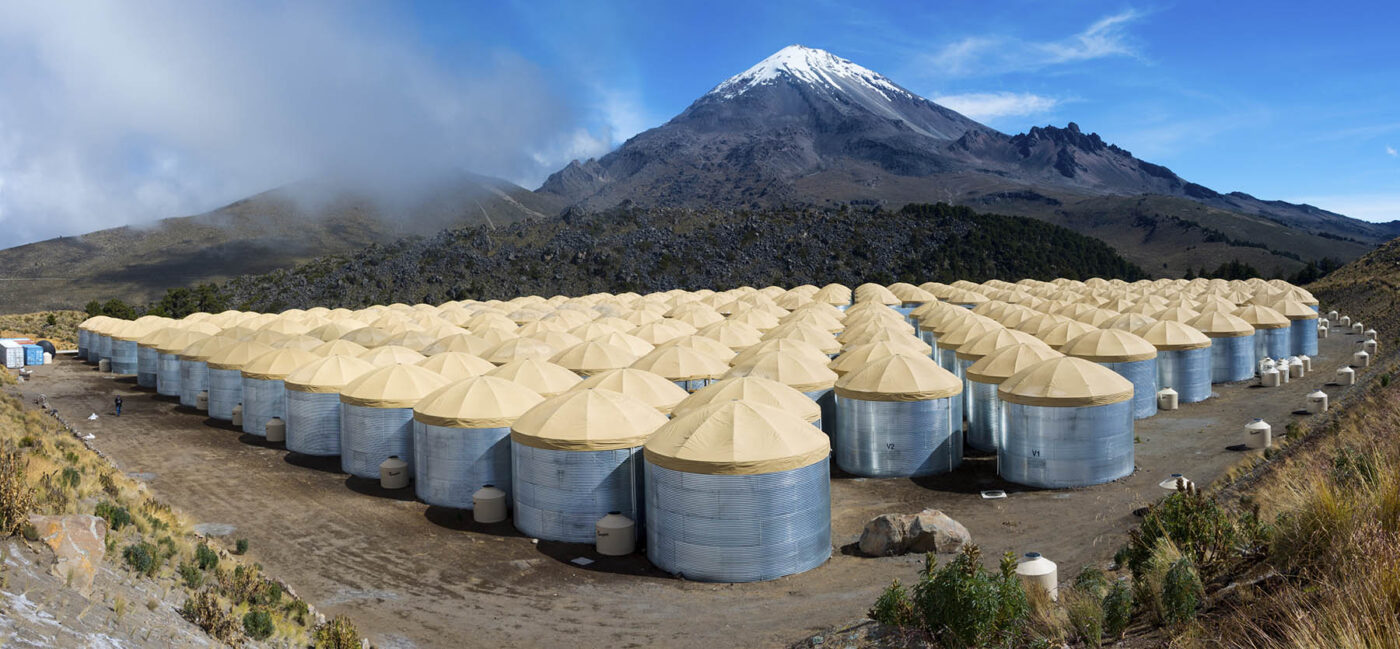projects
HAWC

Overview
The High-Altitude Water Cherenkov, or HAWC, experiment is a TeV-energy-scale gamma-ray observatory located at high altitude (4,100 meters above sea level) in Mexico. Its primary goal is to survey the Northern Hemisphere sky for steady and transient high-energy gamma rays and thereby determine the sources of Galactic cosmic rays. The instrument’s construction was completed in January 2015. The Southern Wide-field Gamma-ray Observatory (SWGO) is a Southern Hemisphere counterpart of HAWC that is currently in the research and development phase.
Research Topics
- Determine origins of cosmic rays
- Measure diffuse gamma-ray spectrum
- Precision measurements of cosmic-ray anisotropy
- Gamma-ray astronomy
Senior Staff
Ke Fang
Paolo Desiati
Juan Carlos Díaz Vélez
Michael DuVernois
Graduate students
Hongyi Wu
David Guevel
Undergraduate Students
Natasha Azad
Riya Kore
Ferris Wolf
WIPAC Contributions
UW–Madison scientists involved with HAWC work on a broad range of topics including trigger design, analysis of cosmic-ray anisotropy, fast searches for flaring activity in astrophysical sources, energy estimation, and map making. Their cosmic ray anisotropy results show patterns in the TeV region in agreement with previous measurements in the Northern Hemisphere.
During construction, the WIPAC team contributed to detector monitoring, tank construction and commissioning, and detector design.
More recently, the WIPAC team has worked on the science analysis of the HAWC data, in particular, the studies of TeV halos around pulsars and the searches for PeV cosmic-ray accelerators (the so-called “PeVatrons”). The team also performs multimessenger observation and phenomenological studies of HAWC sources.
Select Publications
Discovery of Gamma Rays from the Quiescent Sun with HAWC
HAWC Collaboration: A. Albert et al.
Phys. Rev. Lett. 131, 051201 (2023)
journals.aps.org
HAWC Detection of a TeV Halo Candidate Surrounding a Radio-quiet pulsar
HAWC Collaboration: A. Albert et al.
Astrophysical Journal Letters (2023)
https://arxiv.org/abs/2301.04646
All-Sky Measurement of the Anisotropy of Cosmic Rays at 10 TeV and Mapping of the Local Interstellar Magnetic Field
HAWC and IceCube Collaborations: A.U. Abeysekara et al.
Astrophysical Journal 871 (2019) 96; e-print archive arXiv:1812.05682 [astrp-ph.HE]
iopscience.iop.org | arxiv.org
Very-high-energy particle acceleration powered by the jets of the microquasar SS 433
HAWC Collaboration: A.U. Abeysekara, et al
Nature 562 (2018), 82-85
www.nature.com | arxiv.org
Extended gamma-ray sources around pulsars constrain the origin of the positron flux at Earth
HAWC Collaboration: A.U. Abeysekara et al.
Science 6365 (2017), 911-914.
science.org
Multimessenger Gamma-Ray and Neutrino Coincidence Alerts Using HAWC and IceCube Sub-threshold Data
The AMON Team, HAWC and IceCube Collaborations: H. A. Ayala Solares et al.
(journal) Astrophysical Journal 906 (2021) 63l; e-print archive arXiv:2008.10616 [astro-ph.HE]
iopscience.iop.org | arxiv.org
Multimessenger observations of a flaring blazar coincident with high-energy neutrino IceCube-170922A
The IceCube, Fermi-LAT, MAGIC, AGILE, ASAS-SN, HAWC, H.E.S.S, INTEGRAL, Kanata, Kiso, Kapteyn, Liverpool telescope, Subaru, Swift/NuSTAR, VERITAS, and VLA/17B-403 teams
(journal) Science 361, eaat1378 (2018); DOI:10.1126/science.aat1378
science.sciencemag.org | arxiv.org
All-particle cosmic ray energy spectrum measured by the HAWC experiment from 10 to 500 TeV
HAWC Collaboration: R. Alfaro et al
(journal) Phys. Rev. D 96, 122001
journals.aps.org | arxiv.org
Multiwavelength Follow-up of a Rare IceCube Neutrino Multiplet
IceCube, ASAS-SN, The Astrophysical Multimessenger Observatory Network, Fermi, HAWC, LCO, MASTER, Swift, VERITAS: M. G. Aartsen et al
Astronomy and Astrophysics 607 (2017) A115; e-print archive arXiv:1702.06131 [astro-ph.HE]
www.aanda.org | arxiv.org
Search for TeV Gamma-Ray Emission from Point-like Sources in the Inner Galactic Plane with a Partial Configuration of the HAWC Observatory
HAWC Collaboration: A. U. Abeysekara et al
(Journal Article) submitted to Astrophys. J., e-print archive: arXiv: 1509.05401 [astro-ph.HE], September 2015
arxiv.org
Milagro Limits and HAWC Sensitivity for the Rate-Density of Evaporating Primordial Black Holes
Milagro collaboration: A. A. Abdo et al. and HAWC Collaboration: A. U. Abeysekara et al
(Journal Article) Astropart. Phys. 64 (2015) 4-12; e-print: arXiv:1407.1686 [astro-ph.HE]
arxiv.org
Search for Gamma Rays from the Unusually Bright GRB 130427A with the HAWC Gamma-Ray Observatory
HAWC Collaboration: A.U. Abeysekara et al
(Journal Article) Astrophys. J.800 (2015) 78; DOI: 10.1088 0004-637X 800 2 78; e-print: arXiv: 1410.1536 [astro-ph.HE]
arxiv.org
The Sensitivity of HAWC to High-Mass Dark Matter Annihilations
HAWC Collaboration: A. U. Abeysekara et al
(Journal Article) Phys. Rev. D90 (2014) 122002; DOI: 10.1103/PhysRevD.90.122002; e-print: arXiv:1405.1730 [astro-ph.HE]
arxiv.org
Observation of Small-scale Anisotropy in the Arrival Direction Distribution of TeV Cosmic Rays with HAWC
HAWC Collaboration: A. U. Abeysekara et al
(Journal Article) Astrophys. J. 796 (2014) 108; DOI: 10.1088/0004-637X/796/2/108; e-print: arXiv:1408.4805 [astro-ph.HE]
arxiv.org
Sensitivity of the High-Altitude Water Cherenkov Detector to Sources of Multi-TeV Gamma Rays
HAWC Collaboration: A. U. Abeysekara et al
(Journal Article) Astropart. Phys. 50-52 (2013) 26-32; DOI: 10.1016/j.astropartphys.2013.08.002; e-print archive arXiv:1306.5800 [astro-ph.HE]
arxiv.org
On the Sensitivity of the HAWC Observatory to Gamma-Ray Bursts
HAWC Collaboration: A. U. Abeysekara et al
(Journal Article) Astropart. Phys. 35 (2012) 641-650; DOI: 10.1016/j.astropartphys.2012.02.001; e-print archive arXiv:1108.6034 [astro-ph.HE]
sciencedirect.com | arxiv.org
